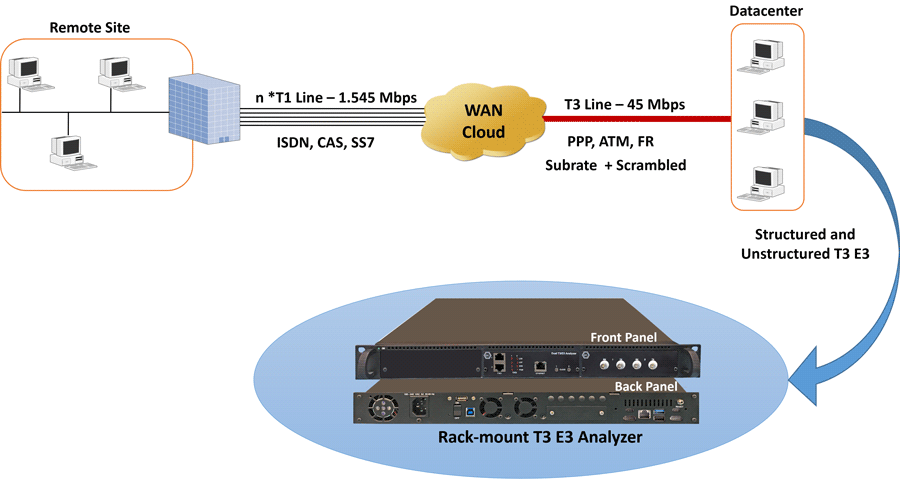T3 E3 Testing for Channelized & Unchannelized Analysis & Emulation
Welcome to our latest issue of GL Communications' newsletter providing information and insight into our T3 E3 Analyzer .

Overview
GL’s T3 E3 Analyzer is capable of processing signaling, voice, and data in full T3 (DS3) or E3 data streams, dropping and inserting T1 (DS1) or E1, and performs analysis of HDLC, ATM, Frame Relay, and PPP Protocols. It includes various signal testing capabilities for Unchannelized (Unstructured) and Channelized (Structured) T3 E3 Traffic.
A T3 line is an ultra-high-speed signal capable of transmitting data at rates up to 44.736 Mbps. An E3 signal is situated at the third level within the Plesiochronous Digital Hierarchy (PDH) and has a bit rate of 34.368 Mbps. The channelized option in the T3 E3 Analyzer uses “software-only” approach to support direct access to all 2x28 T1s or 2x21 E1s or 2x16 E1s on a T3/E3 line per board for emulation, analysis and monitoring– all within a single PC, including differing T1/E1 framing formats, physical layer alarms, and payloads.
As depicted above, GL also offers mTOP™ T3 E3 Probe and Rack variants, which includes one or more of the USB based T3 E3 Analyzer hardware unit combined with necessary PC interface (Intel i3/i7, 256GB HDD, 8GB memory, Win10 Pro 64 bit), making it suitable for field testing (Probe version) and high density lab testing (Rack version) respectively.
Features
- Unchannelized (Unstructured) Testing
- WAN Testing
- Analysis and simulation of ATM, PPP, HDLC, and Frame Relay protocols
- Transmit / Verify HDLC frames with user defined headers
- supports scrambling and subrate for the following DSU vendors' algorithms for T3 interface: Digital Link, Larscom, Verilink, and Adtran
- Channelized (Structured) Testing
- With Drop and Insert Functionality –
- Uses the Dual T1 E1 ports on the hardware
- Multiplex / De-multiplex T1 (DS1) /E1 signals (Drop and Insert).
- Receivers for bidirectional monitoring with Dual T1 (DS1)/E1 drop
- Transmit multiplexed externally inserted or internally generated T1/E1 streams into T3 (DS3)/E3
- Stress test M13 (E13) multiplexers and 3/1 Digital cross connect systems.
- Dual channel drops and insert of T1/E1 signals from any one of the T3 (DS3) /E3 signals
- Broadcast or Loopback Individual T1s/E1s received from T3 (DS3) /E3
- With T1 E1 Tx/Rx Server Software –
- T1/E1 frames are transmitted by the T1 E1 Transmit Server over T3/E3 lines
- T3/E3 Data is received by the T1 E1 Send/Receive Server, whi
- Receive 21 E1 Channels per port (G.747 Mapping) per port from T3 signal
- Receive 16 E1 Channels per port from E3 signal
- Supports monitoring of framed and unframed T1/E1 (Rx Only)
- Simultaneous analysis of all 56 T1s (1.544 Mbps each), or 32 E1s (2.048 Mbps each)
- Analysis of Fractional T1s and E1s, N x T1s or N x E1s,
- Analysis of any combination of DS0s (64 kbps each) within the T1s or E1s, 56 x 24 = 1,344 DS0s for T1 or 32 x 32 = 1024 DS0s
- Supports Protocol Analysis of all structured protocols – HDLC, ISDN, CAS, and many more
- Monitoring of T1 E1 Alarms, Payload, and Framing structure
For comprehensive information on the application, please visit our T3 E3 Analyzer web page.
 Back to Newsletter Index Page
Back to Newsletter Index Page